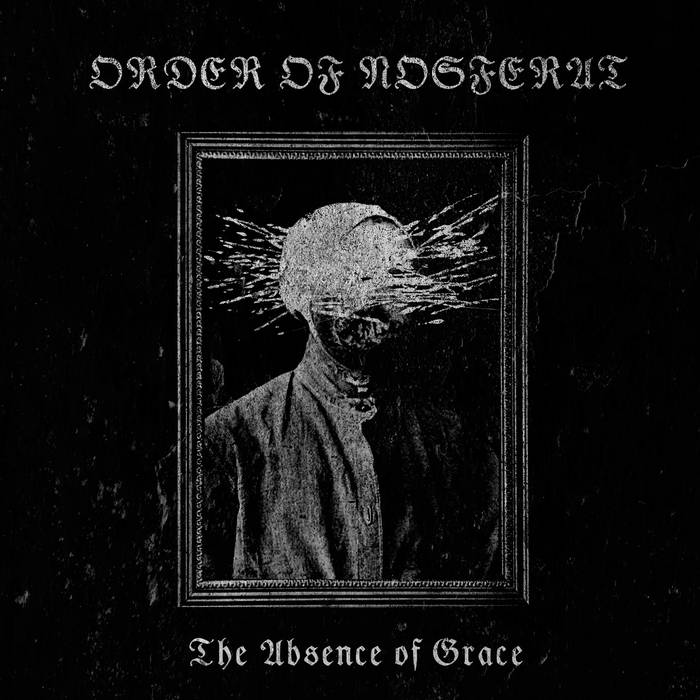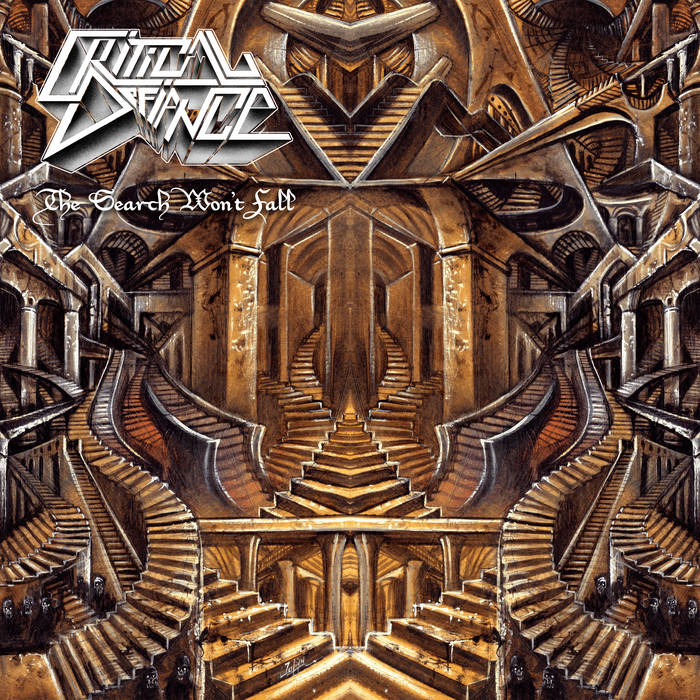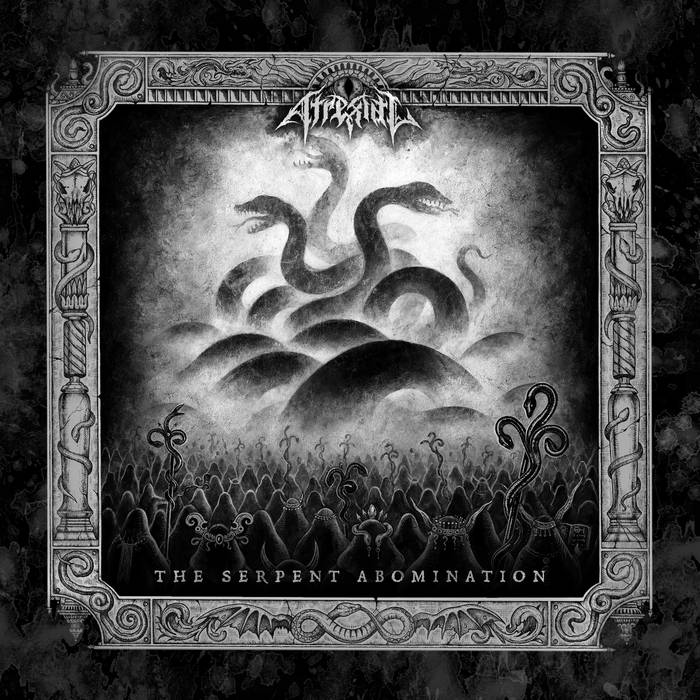Order of Nosferat: The Absence of Grace
Out 21st March on Purity Through Fire

Order of Nosferat typify what many modern critics of black metal mean when they refer to a homogenous, over saturated blob of demos, dog whistles, and very little imagination. If you ever read an interview with some wizened veteran lamenting the scene’s anonymously driven entropy, look no further than artists like Order of Nosferat to put a face on this process. But credit where it’s due, they have shifted gear with their latest album. Maybe waiting at least a year between releases for once did them good. ‘The Absence of Grace’ is every bit as flat, predictable, and derivative as previous works. They are still pretty much what would happen if the concept of generic lo-fi vampiric black metal just willed itself into existence. But the melodic licks (and they are licks) are imbued with a clear thematic intent. Guitars and the accompanying keyboard harmonies conspire to create a bittersweet melancholia. But they never veer too far into gauche self-indulgence. A pleasing restraint is maintained throughout, which is impressive, because tonally this album is surprisingly single minded, keeping things cold, thoughtful, and understated. Order of Nosferat remain utterly superfluous, but with ‘The Absence of Grace’ they at least accept this mantle with a degree of….grace.
Critical Defiance: The Search Won’t Fall…
Out 22nd March on Unspeakable Axe Records/Dying Victims Productions

Dynamic Chilean thrash featuring former members of the neoclassically inclined Demoniac, this album exhibits many of the key strengths currently emanating from this region. It combines studied imagination at the granular level with an increasingly rare spontaneity and energy. Yes, Critical Defiance represent a clear continuity with the past. All thrash tends to carry the nostalgia baggage more so than its sister genres. But Critical Defiance treat these features as a starting point, a foundation upon which to place all manner of modules and intriguing divergences. And this is precisely what distinguishes it from base nostalgia. This is thrash that is conscious of the passage of time, working in the euphoric, rage fuelled riffing and lead guitar material of the past with more sophisticated melodic topographies borrowed from extreme metal. These are integrated seamlessly into a unified vision. The fluidity of the genre hopping could just as easily go unnoticed for the sake of enjoying the compositions at the macro level for their sheer imaginative novelty. This appears to be a common feature of much thrash and death metal coming out of Chile at present. Not a clear break with the past, but a rehabilitation of it, updating it into an entity fit for a confrontation with the contemporary moment.
Moon Incarnate: Hymns to the Moon
Out 22nd March on Iron Bonehead Productions

Takes the meandering twists of early My Dying Bride and manipulates them toward a more aggressive, nihilistic place. The bleak melancholia of the Peaceville three is clearly placed front and centre on Moon Incarnate, but there is an underlying hostility at the core of these pieces that updates the format with a wearied modern sheen. The despondent romanticism is pulled in one direction by a blunt realism, and in another by moments of surrealism via arrested momentum, eccentric vocal choices, and subtle but clever use of keyboards. Repetition is utilised more than is usual for melodic death/doom. Individual hooks are deployed as a means of hanging ancillary material on. Working upwards from the basic droning guitars, to the slow build of synth chords or artificial choir patches, to vocals that veer from guttural death growls to hints of tragedian clean tones, as if to emphasise the underlying emotivism beneath the violence. But it’s repetition with a purpose, every simple refrain is serviced with a development, or else builds into the next transitory passage. The sense of journey and progression is never dropped in favour of mere texture play. The latter of which is present, but always as a way to elevate the forward motion of the music. The pieces are always driving forward despite the depressed tempos and drab delivery. Eccentric, imaginative, weird, yet pleasingly sparse and understated when taken against comparable works within the gothic death/doom sphere.
Brodequin: Harbinger of Woe
Out 22nd of March on Season of Mist

Brodequin attempt to distinguish themselves from the usual brutal death metal crop via a preoccupation with medievalism (comparable to Sarpanitum). This manifests through little more than the packaging material and the occasional nod to traditional melodic contours. For the most part however, Brodequin use brutal or technical death metal as a kind of filter through which to funnel other styles through. The riffs most recognisably “brutal” are when Brodequin are at their most uninspiring. This album shines when a melodic doom segment is injected with odd rhythmic content, or a proto black riff is reconfigured into constricted form via tight, palm muted spaces. The percussive death metal benefits from non-chromatic forms breaking up the monotony of near constant disruptive riffing that seems to define the modern form, whilst the styles they are lifted from are presented under different lighting, allowing us to study new angles and gradients within their content. It’s also worth noting the latent atmosphere that stretches itself across the entire album, serving the arcane aesthetic Brodequin are trying to get across without being so pronounced as to distract from the dense riff exercises beneath.
Atrexial: The Serpent Abomination
Out 22nd March on Non Serviam Records

Combines the dissonance of Icelandic black metal with boredom. Atrexial cook up nearly an hour’s worth of tired, oppressive drabness for their latest offering, typifying much of what’s wrong with the so called black metal renaissance. Namely, a very clear idea of what black metal should look and feel like, but very little thought given to what’s actually occurring at a musical level. This is demonstrated by the fact that Atrexial seem incapable of stitching individual components together without deploying a crescendo into a complete breakdown as preparatory material for the next passage. This is an important and much used compositional tool, but as it’s the only tool Atrexial use to transition between ideas, it shapes the album into a series of shortform pieces with no overarching motivation. . And all the ability, guitar layers, dissonance resolving to consonance, and cinematic production can’t hide just how unfinished this music appears. If anything, it makes the experience worse as the dramatic stakes are hammed up to the point of monotony but continue to impose upon the listener, who in turn can’t switch off to the lack of intellect behind the cacophony beyond a collage of familiar tropes, leaving us wondering what the motivation is behind all this activity. Where Carpe Noctem and Svautidaudi (and indeed Mayhem on ‘Ordo ad Chao’) were able to leverage a similar aesthetic package into a place distinct from pre-millennial black metal, Atrexial and so many comparable acts seem to have only grasped the outline of what made this stylistic shift novel, whilst failing to furnish us with any further detail on what they are actually adding to the collective pool.
Endless Loss: Traversing the Mephitic Artery
Out 25th March on Nuclear Winter Records

Shores up ultra primitive blackened grind with a throughline of melody. Whilst this may therefore look like standard war metal tedium from a presentational perspective, it actually consolidates the style with a degree of intent. Endless Loss sacrifice none of the intensity in attempting to facility a conversation between riffs, as distinctive peaks and troughs engage in a dialogue with the off-beat vocals, allowing both to serve as monstrous narrators through the many corridors of noise. Tempo changes and dirge ridden accents are deployed to great effect, not only contrasting with the style’s blasting raison d’etre, but serving as framing diverse, enhancing the communicative power of individual riffs despite their rudimentary form. The production aides in this endeavour through a degree of what we’ll call chasmic restraint. ‘Traversing the Mephitic Artery’ very much aligns with the aesthetic of blackened deathgrind, but where many fall into the trap of drowning everything in a cacophony of reverb, Endless Loss are surprisingly conservative in this regard, allowing the guitar tone and vocals to carry the weight of atmosphere. As a result the riff geography is made visible, and serves as the chief talking point over and above the surface level muscularity and intense gloom.
Leave a comment